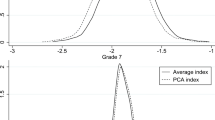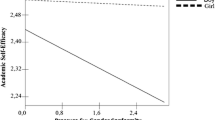Abstract
The present study examines consequences of high peer pressure on academic performance in mathematics among 14-year-old middle-school students in Germany, Canada, and Israel. Its core assumption is that students with very high abilities in mathematics underachieve in order to avoid social exclusion (in the form of being called, e.g., nerds) in their schools. Altogether almost 1,700 students were surveyed in the three cultures. Findings of the study make it obvious that—concerning achievement in mathematics—the primary victims of peer pressure in middle school are girls, boys more likely than girls being the perpetrators. High individual preferences of achievement values can buffer effects of peer pressure. However, from a pedagogical point of view it may nevertheless seem an option to teach mathematics in mono-gender courses, in order to improve the chances of both girls and boys to show an academic performance that concurs with their real competence.
Similar content being viewed by others
References
Arbuckle J.W. (2006). AMOS 7 User’s guide. Chicago, SPSS
Austin A.B., Draper D.C. (1981). Peer relationships of the academically gifted: A review. Gifted Child Quarterly 25, 129–133
Bardi A., Sagiv L. (2003). The EU and Israel: Comparing of cultures and implications. In: Boehnke K. (ed). Israel and Europe: A complex relationship. Wiesbaden, DUV, pp. 13–36
Berndt T., Keefe K. (1995). Friends’ influence on school adjustment: A motivational analysis. In: Juvoven J., Wentzel K.R. (eds). Social motivation: Understanding children’s school adjustment. Cambridge, Cambridge University Press, pp. 248–278
Bishop J.N. (1999). Nerd harassment, incentives, school priorities, and learning. In: Meyer S.E., Peterson P.E. (eds). Earning and learning: How schools matter. Washington DC, The Brookings Institution, pp. 231–280
Boehnke, K. (1996). Is intelligence negligible? The relationship of family climate and school behavior in a cross-cultural perspective. Münster: Waxmann.
Brown B.B., Steinberg L. (1990). Academic achievement and social acceptance: Skirting the “brainnerd” connection. Education Digest 55(7): 55–60
Brown B.B. (1990). Peer groups and peer cultures. In: Feldman S.S., Elliot G.R. (eds). At the threshold: The developing adolescent. Cambridge, MA, Harvard University Press, pp. 171–196
Cowie H. (2000). Bystanding or standing by: Gender issues in coping with bullying in English schools. Aggressive Behavior 26, 85–97
Cooper C., Denner J. (1998). Linking culture and psychology: Universal and community specific theories. Annual Review of Psychology 49, 559–584
Dempster A.P., Laird N.M., Rubin D.B. (1977). Maximum likelihood from incomplete data via the EM algorithm. Journal of the Royal Statistical Society, B 39: 1–38
Feather N.T. (1989). Attitudes towards the high achiever: The fall of the tall poppy. Australian Journal of Psychology 41(3): 239–267
Hannover, B. (1999). Schulischer Kontext, geschlechtsbezogenes Selbstwissen und Fachpräferenzen [School context, gender-related self-knowledge, and subject preferences.] In B. Hannover, U. Kittler, & H. Metz-Göckel (Eds.), Sozialkognitive Aspekte der pädagogischen Psychologie. Vol. I. Dokumentation des 3. Dortmunder Symposions für Pädagogische Psychologie 1998 (pp. 125–139). Essen: Die Blaue Eule.
Helmke A. (1992). Selbstvertrauen und schulische Leistungen [Self-esteem and academic performance]. Hogrefe, Göttingen
Juvonen J., Murdock T.B. (1995). Grade level differences in the social value of effort: Implications for self-presentation tactics of early adolescents. Child Development 66, 1694–1705
Kindermann T. (1993). Natural peer groups as contexts for individual development: The case of children’s motivation in school. Developmental Psychology 29, 970–977
Kindermann T., McCollam T.L., Gibson E. Jr. (1995). Peer networks and student’s classroom engagement during childhood and adolescence. In: Juvoven J., Wentzel K.R. (eds). Social motivation: Understanding childrens’ school adjustment. Cambridge, Cambridge University Press, pp. 279–311
Köller O., Baumert J., Clausen M., Hosenfeld I. (1999). Predicting mathematics achievement of eighth grade students in Germany: An application of parts of the model of educational productivity to the TIMSS data. Educational Research and Evaluation 5, 180–194
Lerner R.M., Freund A.M., De Stefanis I., Habermas T. (2001). Understanding developmental regulation in adolescence: The use of the selection, optimization, and compensation model. Human Development 44, 29–50
Manor-Bullock R., Look C., Dixon D.N. (1995). Is giftedness socially stigmatizing? The impact of high achievement on social interactions. Journal for the Education of the Gifted 18(3): 319–338
Martin, M. O., Mullis, I. V. S., Gonzalez, E. J., Gregory, K. D., Smith, T. A., Chrostowski, S. J., Garden, R. A., & O’Connor, K. M. (2000). TIMSS 1999. International science report: Findings from IEA’s repeat of the Third International Mathematics and Science Study at the eighth grade. Chestnut Hill, MA: International Study Center, Boston College, Lynch School of Education.
Mullis, I. V .S., Martin, M. O., Gonzalez, E. J., Gregory, K. D., Garden, R. A., O’Connor, K. M., Chrostowski, S. J., & Smith, T. A. (2000). TIMSS 1999. International Mathematics Report: Findings from IEA’s Repeat of the Third Intentional Mathematics and Science Study at the eighth grade. Chestnut Hill, MA: International Study Center, Boston College, Lynch School of Education.
Rigby K. (2002). New perspectives on bullying. London, Jessica Kingsley
Schroeder-Davis S.J. (1999). Brains, brawn, or beauty: Adolescent attitudes toward three superlatives. Journal of Secondary Gifted Education 10(3): 134–147
Schwartz S.H. (2004). Mapping and interpreting cultural differences around the world. In: Vinken H., Soeters J., Ester P. (eds). Comparing cultures: Dimensions of culture in a comparative perspective. Leiden, Brill, pp. 43–73
Schwartz S.H., Melech G., Lehmann A., Burgess S., Harris M., Owens V. (2001). Extending the cross-cultural validity of the theory of basic human values with a different method of measurement. Journal of Cross-Cultural Psychology 32, 519–542
Scott R., Scott W.A. (1998). Adjustment of adolescents: cross-cultural similarities and differences. London, Routledge
Steele J., James J., Barnett R. (2002). Learning in a man’s world: Examining the perceptions of undergraduate women in male-dominated academic areas. Psychology of Women Quarterly 26(1): 46–50
Uguroglu M.E., Walberg H.J. (1986). Predicting achievement and motivation. Journal of Research and Development in Education 19, 1–12
Walberg H.J., Singh R.P., Tsai S.-L. (1984). The achievement productivity of psychological variables: A replication and extension in Rajasthan, India. The Alberta Journal of Educational Research 30, 171–178
Walsh M., Hickey C., Duffy J. (1999). Influence of item content and stereotype situation on gender differences in mathematical problem solving. Sex Roles 41(3–4): 219–240
Author information
Authors and Affiliations
Corresponding author
Rights and permissions
About this article
Cite this article
Boehnke, K. Peer pressure: a cause of scholastic underachievement? A cross-cultural study of mathematical achievement among German, Canadian, and Israeli middle school students. Soc Psychol Educ 11, 149–160 (2008). https://doi.org/10.1007/s11218-007-9041-z
Received:
Accepted:
Published:
Issue Date:
DOI: https://doi.org/10.1007/s11218-007-9041-z




